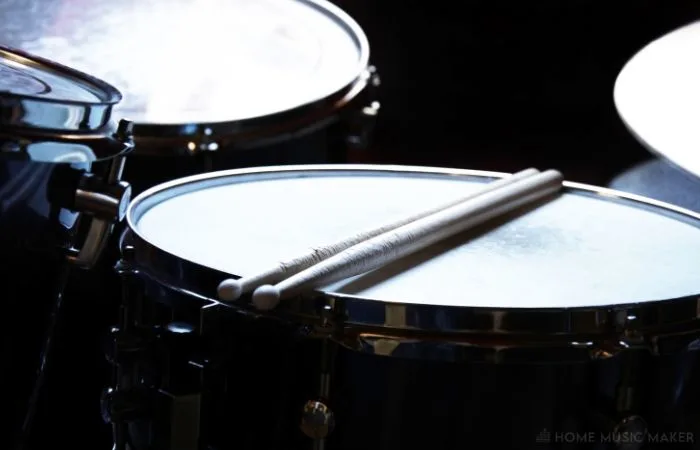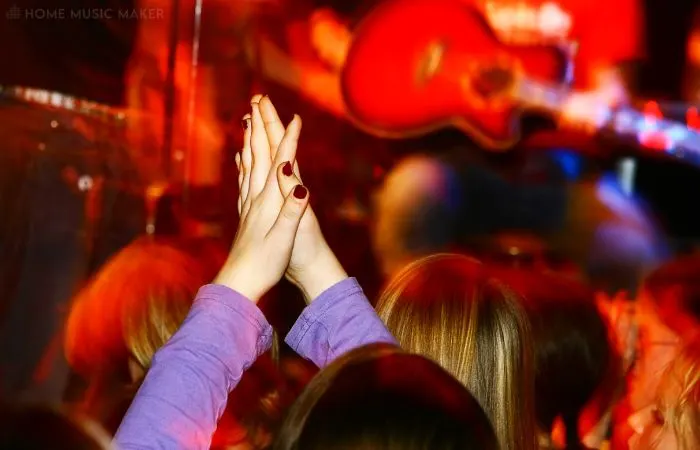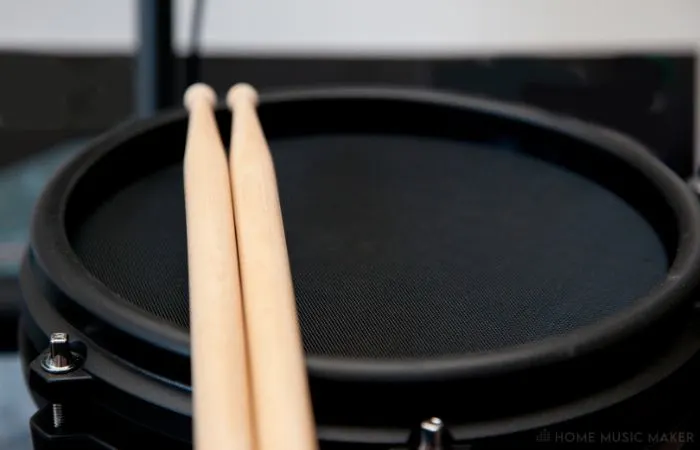KEY TAKEAWAYS:
In the world of music production, the snare and clap are two separate but similar sonic elements. They can add something different to a track or a specific song section. You should consider using both snares and claps in your tracks to get the most from them.
Snares And Claps In Music Production
You must consider the snare and the clap as separate music production elements and understand the differences.
I was not knowing the distinction between snares and claps when producing music results in you missing out on potential songwriting and dynamic opportunities.
I have been producing music for about ten years now and have had the chance to explore different ways of using both snares and claps in my tracks.
This in-depth article will examine the difference between the snare and the clap and how you can use them together.
What Is A Snare And How Is It Used In Music?
In music production, ‘snare’ refers to the percussive sound that primarily hits on beats two and four.
A snare can either be a recorded acoustic snare drum or an electronic sound meant to replicate the crack of a snare drum.

For example, a rock, country, or blues band will almost always have a drummer who plays an actual snare drum. On the other hand, a rap or EDM song will probably use some synthesized electronic snare sound.
Although it might sound different depending on the genre, any song with a rhythm will feature a ‘snare’.
The History Of The Snare Drum
According to historical records, the snare drum dates back to the early 1300s. The Tabor, another type of medieval drum, inspired its design.
Over the years, it has become a staple for orchestras, drum lines, bands, music producers, and pretty much any other type of music creator.
Although it will have a different sound depending on the genre or application, the snare drum is crucial for creating both traditional and modern music.
Different Types Of Snare Drums
There are many types of snare drums for the different applications musicians use them for. They are usually made of wood, metal, or sometimes acrylic.
Here are some of the different types of snare drums:
- Marching snare drums.
- Orchestral snare drums.
- Concert or band snare drums.
- Electronic snare drums.
What Is A Clap And How Is It Used In Music?
In music production, a ‘clap‘ is either the sound of a literal human hand clap or a sound replicating it. Music producers use it as a percussive sound that often falls on beats two and four, much like the snare.

You can use a clap with a snare to give it some extra power and presence, or you can use it alone to change the dynamics of a particular song section.
A clap is a widespread music production tool that you can use individually or in combination with a snare.
The Evolution Of The Clap Sound
In music, the clap started as nothing but a recorded human clap. Often, a group singer would clap along with the band as they play, which would be the clap you hear in the song.
Since then, music producers have modified the clap using FX and processing so that it will sometimes sound not much like a human clap at all. Of course, modern musicians and producers still use the natural human clap.
You will hear the clap in genres such as oldies, funk, disco, blues, rock, country, hip-hop, EDM, pop, etc.
Using Claps In Modern Music Production
In modern music production, you will hear producers use the clap in a few different ways.
Here are some of the more common uses for claps in modern music production:
- In combination with a snare to give the snare an extra crack.
- On a different beat than the snare falls, adding some rhythm variation.
- By itself to change the dynamics of a song.
- With a bunch of effects to create a totally unique sound.
As you can see, music producers have many different ways of using claps to help them create a great track.
READ NEXT:
To put a beat together, you will need a DAW. If you don’t already have one, you should check out our article on whether Pro Tools is the ultimate beat-making software.
Snare Vs. Clap: Similarities And Differences
Let’s look at the similarities and differences between the snare and the clap.
Similarities
- They are both percussive musical elements.
- They both often fall on beats two and four.
- They both have a very present sound profile.
Differences
- The snare has a bit more low-end presence, while the clap is typically more rooted in the high-end.
- The snare can sometimes sound very electronic, while most claps will have some human-sounding element, even if they are heavily processed.
- A snare sound comes from a snare drum, while a clap sound comes from a human clap.
The Role Of Snare And Clap In The Rhythm Section
In the rhythm section, the snare and the clap typically drive beats two and four.
They have a present ‘crack‘ sound that makes them perfect for this purpose.
Keep in mind, sometimes the snare or clap will not fall on two and four, and although this is a bit less common, it can make for a fascinating rhythm.
The snare and the clap contrast well with the low-end sound of a bass drum or bass drum sample and are essential sonic elements in the rhythm section.
READ NEXT:
Check out this other article that we have to learn how to dial in your kick drum compression.
How Snare And Clap Affect The Overall Sound Of A Song
Let’s compare how the snare and the clap can affect the overall sound of a song.
Snare
A snare can add more power to your song than a clap can. This is because the snare has a high-end and low-end/low-mid presence.
The sound profile of a snare can make your beat more full and powerful than a clap usually can.
Clap
The frequency response of a clap is primarily rooted in the high-mids and high-end.
This lack of low-end and low-mid presence will make your beat thinner than if you use a snare sound. This can be perfect for changing the dynamics of a specific song section and adding some variation to your track.
Choosing The Right Snare And Clap For Different Musical Genres
When choosing the right snare and clap, you must consider what genre you’re working in and then select accordingly.
For example, if you are working on a rock, blues, country, funk, disco, or indie song, you should use an actual snare drum/human clap sound.

However, suppose you are working on an electronic, hip-hop, or pop track. In that case, consider using electronic snare and clap sounds.
Choosing a snare and clap that works for your track can be tricky, but do your research, and you will find ones that work for you and your track.
Using Snare And Clap Together In Music Production
Using snares and claps simultaneously is the way to get the most from both of them!
It would be best if you didn’t consider it an issue of snares against claps. Instead, consider the best ways to use both snares and claps to enhance your track.
Layering Snare And Clap For Maximum Impact
I recommend layering up a snare and clap sound to get maximum impact on the track you’re working on.
To do this, find a snare and clap sound that works together and blend their volume levels to taste. It can be surprising how much this adds to your track!
Using both a snare and clap in your track can help drive the song’s beat.
Creating Contrast and Dynamics with Snare and Clap
Another great way to use snares and claps together is for different sections within a song.
For example, if you want to start a bit quieter before a beat drop, you can use a clap sample for this section and switch to a snare when you want the beat to hit!
Conversely, you can have a snare playing during a loud section and then switch to a clap once the track transitions to a quieter one.
I recommend using snares and claps at different times to add dynamics to your song’s various sections.
Advanced Techniques For Blending Snare And Clap
Here are a few other more advanced ways that you can blend snares and claps in your song:
- Have the snare hit on beats two and four only but have claps play on off beats to add some variation to your rhythm.
- Have a snare and clap both falls on two and four but add some unique processing to one of them such as reverb, delay, etc.
- During a build-up, keep the snare landing on two and four, but gradually increase the tempo of your claps to add energy.
Feel free to get creative with how you use snares and claps when producing music. You can come up with your own techniques as well.
Creating Unique Snare Or Clap Sounds With Sampling And Effects
Here are some ways that you can create a unique snare or clap sound using sampling and effects:
- Sample a unique sound for a snare or clap noise no one has heard.
- Use reverb to create a spacey snare or clap sound.
- Use delay to dial a sweet echo effect on your snare or clap.
- Modulate the parameters on an EQ to make a snare or clap sound that changes as it plays.
- Use either low- or high-end EQ filtering to change how your snare or clap sounds.
- Try using other effects such as saturation, distortion, chorus, flanger, phaser, etc.
Be bold and try new things when producing music – you never know what you will create.
Related Questions
Are Snares Or Claps More Common In Modern Music Production?
It is typically more common to hear a snare sound in music than a clap.
Claps are also quite common. It just depends on the track and the producer.
You will often hear a snare and clap layered together in a song.
Should I Use A Snare Sample Or An Actual Snare Drum In My Track?
This depends on the track you are working on and the sound you are going for.
A snare sample will typically have a more electronic/hip-hop sound, while an actual snare drum will have a more warm and natural tone.
What Beat Does The Snare Or Clap Typically Fall On In Music?
As a general rule, the snare/clap will fall on the 2 and the 4 in music.
Sometimes this will not be the case depending on the song or genre, but it is a good guideline.
When Should You Use A Snap In A Song?
Using a snap-in music production is less common than a snare or clap.
However, it can be perfect for certain sections of a track.
For example, you’ll sometimes hear the beat cut out, dropping the song to just vocals and snaps.
Using a snap sound instead of a snare/clap can be perfect in certain situations!
What Are The Different Tools I Can Use To Make My Kick And Snare Really Bump?
Let’s take a look at some of the most powerful tools for mixing drums:
– Saturation can add warmth and color to your drum tones.
– EQ will allow you to sculpt the frequency range of your drum sounds.
– Compression will help you tighten and add punch to your drums.
– Noise Gating can help you control the transients and tighten your drums.
Using a healthy balance of these mixing resources is essential instead of going overboard with one another.
Final Words
As you have seen, the snare and the clap are different but equally important music production elements.
It’s mostly a matter of when and how to use each one rather than one being better than the other. Using both snares and claps in a track can add dynamics and help you change certain sections.
If you want to get the most out of your snare and clap samples, learn how to use them together when producing music rather than relying on one or the other.
READ NEXT:
The snare and clap are only a part of the drum sound. To further your knowledge of processing these sounds, check out our article on how to EQ drums.

 Want to connect with other music producers for help and guidance?
Want to connect with other music producers for help and guidance?